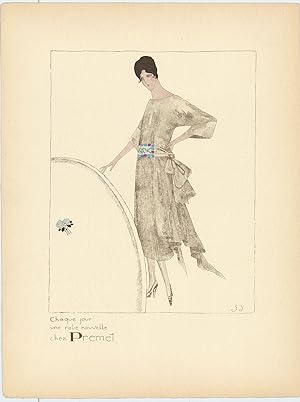About this Item
Original colour-printed pochoir illustration on laid paper (c. 33 x 25 cm). Pochoir, literally the French word for stencil, is both a centuries-old printmaking process and an important chapter in modern graphic arts. Pochoir came to refer to fine stencil printing in the last quarter of the nineteenth century. It reached its zenith in Paris between 1910 and 1935 where it was used to decorate everything from elegant fashion magazines and limited edition illustrated books, to greeting cards, wallpapers and advertisements. Lucien Vogel, taking full advantage of the pochoir technique in 1912, launched the lavishly illustrated monthly fashion magazine, La Gazette du Bon Ton. Vogel employed some of the greatest illustrators of the day to bring to life the newest creations of the Parisian couturiers. The success of La Gazette du Bon Ton fueled the public's desire for chic, colorful "journaux du gout" and gave birth to such publications as the elegant Journal des Dames, the trendy Art, Goût, Beauté, and Vogel's sequel to La Gazette, the superb but short-lived, Les Feuillets d'Art. The 6 issues of Les Feuillets d'Art were published in Paris by Vogel between May 1919 and July 1920. Les Feuillets was issued in limited edition portfolio form. Each issue contained 5 feuillets, or leaves, on the subjects of literature, theatre, arts and design, music, and fashion (issues 3 through 6 have a sixth leaf, les feuillets de la publicité.) Vogel intended for Les Feuillets to be a fashion-savvy review in which he professed a dedication to "finding in the taste of the moment all that is traditional and durable." To accomplish his goal Vogel brought together the crème de la crème of the literary, artistic and musical worlds of 1920's Paris. Amazingly there is poetry by Paul Claudel, the younger brother of sculptor Camille Claudel, the first publication of a composition by Maurice Ravel, and original woodblock prints by Raoul Dufy, Odilon Redon, and John Storrs. The undisputed gems of the publication are its hand painted pochoir prints. They are unaccompanied by text ("hors texte") and are inserted for their beauty alone. The pochoirs can be found in the last two leaves of each volume, as fashion plates in les feuillets de la mode and as advertisements in les feuillets de la publicité. These subtle, charismatic designs were produced by some of the greatest artist/illustrators of the day, Georges Lepape, George Barbier, Edouard Halouze and Charles Martin, to name just a few. All of the pochoirs reflect the geometric modernist style of the Art Deco period. The abundance of pochoirs lasted only a few years after the demise of Les Feuillets. A world economic downturn and machine printing were soon to spell the end of the hand-color process. The pochoir gave way to less expensive forms of photomechanical color printing and very few examples were produced after 1935. Pochoir, which had captured the imagination of a generation of couturiers, artists, and illustrators, became a part of the past, along with the Art Deco style. (The Cleveland Museum of Art). Seller Inventory # 59047
Contact seller
Report this item
![]()
